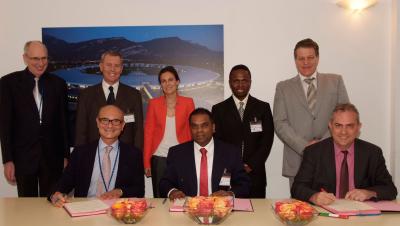- Home
- News
- General News
- South Africa joins...
South Africa joins the ESRF
21-05-2013
On 21st May, South Africa signed a medium-term arrangement with the ESRF at a level of 0.3% and, in doing so, became the 20th country to join the European synchrotron. South Africa’s affiliation is a major milestone in its long-standing determination to reinforce ties with the international synchrotron radiation community. And with the Republic’s well-known attraction to all that shines, the choice to join the world’s brightest light source is befitting.
Share
“It’s a solid achievement that makes us extremely happy” were the words pronounced by Professor Nithaya Chetty, Group Executive for Astronomy at the National Research Foundation (NRF) on signing the medium-term arrangement on behalf of South Africa. The ESRF was represented by Director General Francesco Sette who declared “I’m delighted to welcome South African scientists to the ESRF and look forward to further developing common research programmes and opportunities”.
This arrangement is valid until end 2017 and cements the NRF decision taken at end 2012 to formally participate in the ESRF at a level consistent with the size and interests of the South African scientific community. The ESRF aims to promote South Africa’s use of the facility and encourage a maturation of South Africa’s participation towards the status of Scientific Associate.
Professor Chetty was accompanied by Professor Thomas Auf der Heyde, Deputy Director General of the Department of Science and Technology (DST) and Professor Tshepo Ntsoane, current chairperson of the Synchrotron Research Roadmap Implementation Committee (SSRIC) and senior scientist at the South African Nuclear Energy Corporation (NECSA). The ESRF also invited Professor Simon H. Connell from the Department of Physics of the University of Johannesburg. A regular user of the ESRF, Connell has played an active role in fostering scientific collaboration between the ESRF and South African researchers over the past years.
Current research
Recent research collaborations include a sustained industrial partnership with Sasol, the South African international energy and chemical company based in Johannesburg and operational in 38 countries. The ESRF has enabled Sasol catalysts to be studied under realistic reactor conditions to better understand the chemical transformations that control Fischer Tropsch catalysts on a micro and nano scale. “The high flux, high resolution and very short timescales of measurement offered by the ESRF have meant our venture has already significantly contributed to the fundamental understanding of proprietary catalyst behaviours”, reports Dr Esna du Plessis, a scientist from Sasol, directly involved with the South African synchrotron community.
In 2011, a research team led by K.J. Carlson from the University of Witwatersrand and Indiana University (USA) used the high quality imaging provided by ESRF’s ID17 and ID19 beamlines to study the brain cavities of Australopithecus sediba fossils almost 2 million years old. The results helped clarify the debate concerning the gradual increase of brain volume in human lineage following the transition from Australopithecus to Homo.
South Africa present since ESRF inauguration in 1994
South Africa has been involved with the ESRF since the beginning of user operation in 1994. That year, Trevor Derry, then later Jacques Pierre Friederich Sellschop, both from the University of Witwatersrand, used the ESRF to carry out the first research on diamond surfaces using synchrotron light.
In 1996 Giovanni Hearne, currently at the University of Johannesburg, used the ESRF to study materials under extreme pressures. Bryan Doyle, also now at the University of Johannesburg completed postdoctoral research at the ESRF in 1999.
These early efforts sparked the emergence of the South African synchrotron light source community which has been growing ever since. Collaboration with the ESRF has continued to strengthen and flourish and important breakthroughs have been achieved, notably in the domains of palaeontology and paleoanthropology, materials science, and macromolecular crystallography.
An industrial partnership was established in the early 2000s between Element Six Technologies (Johannesburg, South Africa), the University of Johannesburg and the ESRF to coordinate and intensify efforts to develop diamond based X-ray beam optical elements for premier X-ray sources. The optical elements that resulted from this industrial R&D are now regular features in high energy synchrotrons worldwide and X-ray Free Electron Lasers (XFELs).
In December 2011, the Synchrotron Research Roadmap Implementation Committee (SSRIC) organised a Strategic Plan Workshop to which the ESRF DG and several ESRF senior scientists were invited and which counted the presence of representatives from the Department of Science and Technology (DST) and from the National Research Foundation (NRF) of the Republic of South Africa.
The SRRIC documented the outputs of this workshop in March 2012 in the form of a white paper strategic plan, in which one of the main actions was to strengthen the relationships of the South African synchrotron science community and its government with foreign light source facilities, and especially with the ESRF.
Text by Kirstin Colvin
Top image: ESRF opens affiliation to a new continent: South Africa joins the European synchrotron.




